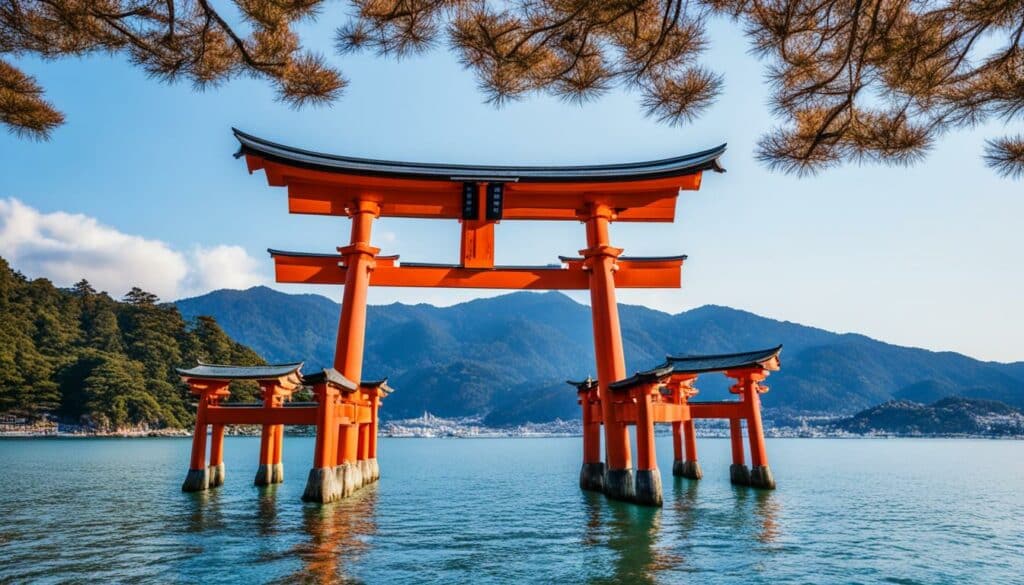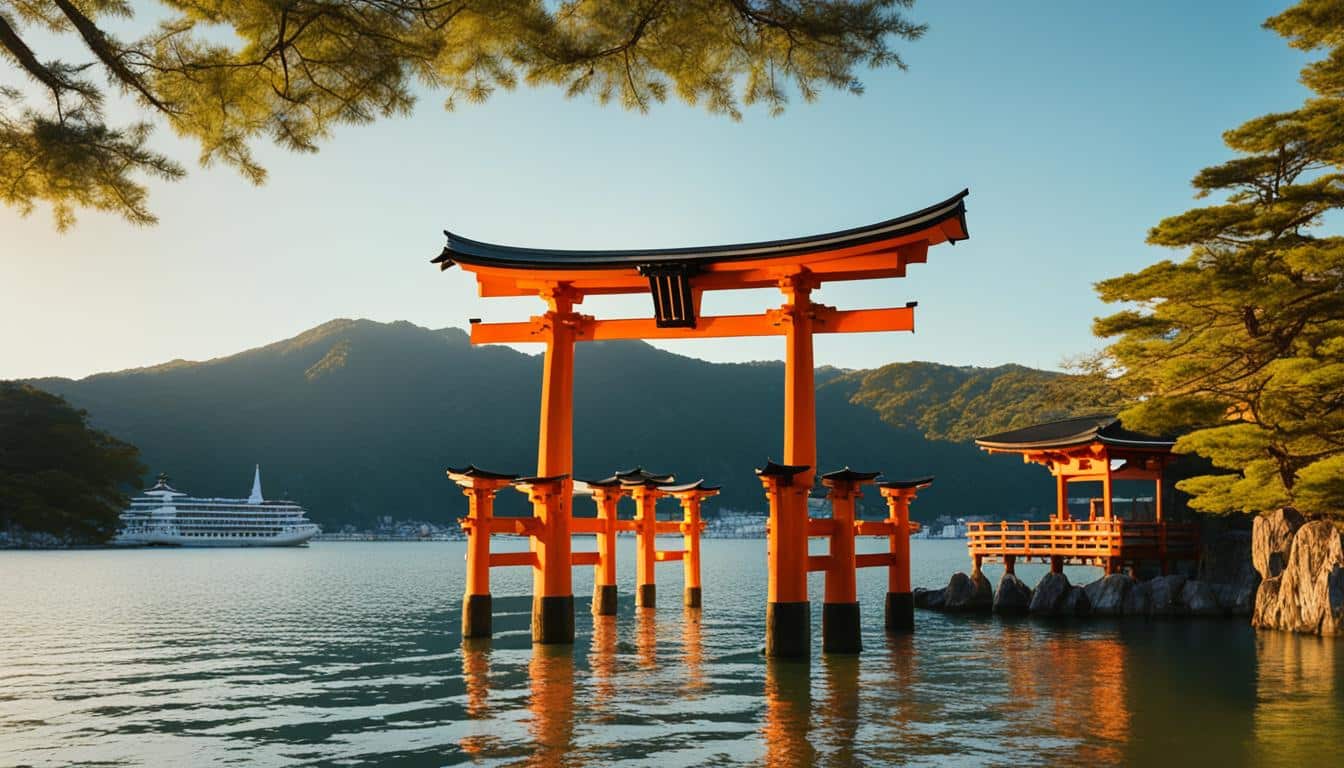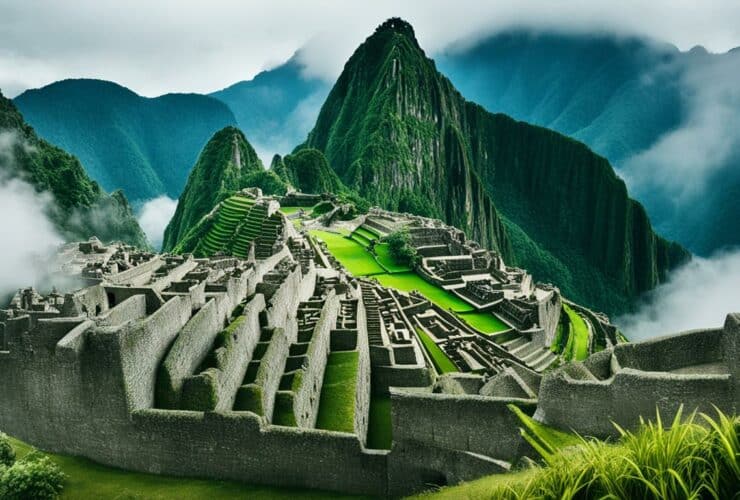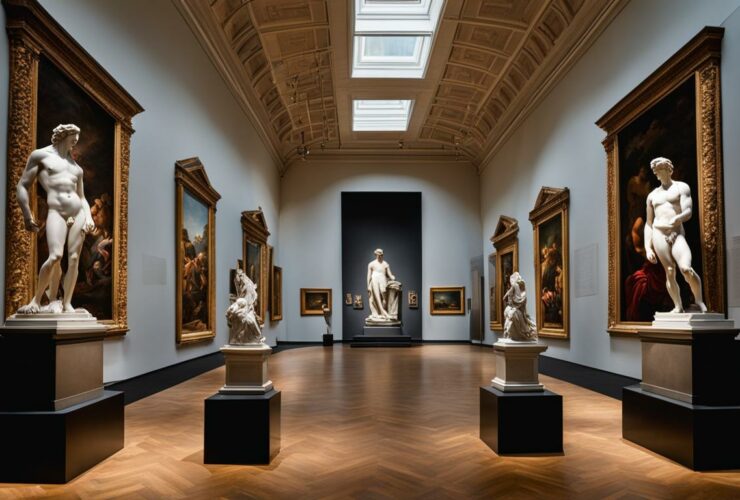Welcome to our exploration of Itsukushima Shrine, a famous and revered shrine in Japan. Known for its breathtaking beauty and spiritual significance, this architectural marvel is also a designated UNESCO World Heritage Site. Join us as we uncover fascinating facts about this iconic shrine and discover why it is a must-visit destination for travelers from around the world.
Key Takeaways:
- Itsukushima Shrine is a famous and revered shrine in Japan.
- It is a designated UNESCO World Heritage Site.
- The shrine is known for its breathtaking beauty and spiritual significance.
- Its iconic floating torii gate is a mesmerizing feature.
- Visit the shrine on Miyajima Island to experience its awe-inspiring beauty and cultural significance.
A Jewel on Miyajima Island
Situated on Miyajima Island, Itsukushima Shrine holds a rich historical significance in Japanese culture. This sacred island destination is steeped in tradition and frequented by both pilgrims and visitors seeking a spiritual experience.
Miyajima Island, also known as Itsukushima Island, is located in the Seto Inland Sea, southwest of Hiroshima Prefecture. The island has a storied past, dating back centuries and serving as a sanctuary for worshippers and travelers alike.
The island’s history is intertwined with the development of Itsukushima Shrine, which was first established in the 6th century. Throughout the centuries, the shrine has been renovated and expanded, becoming the iconic structure it is today.
“Historically, Miyajima Island has been considered a sacred destination. It is believed that the island itself is a deity, and this spiritual connection draws people from all over the world.”- Local Historian
The island’s natural beauty adds to its allure, with lush forests, scenic mountains, and breathtaking coastline. Visitors can immerse themselves in the tranquility and serenity of the island, taking in the picturesque landscapes and connecting with nature.
A stroll along the island’s streets reveals traditional Japanese architecture, quaint shops, and local delicacies, providing a taste of the island’s vibrant culture. From street festivals to cultural performances, Miyajima Island offers a myriad of experiences for every traveler.
Overall, Miyajima Island’s historical significance and sacred charm make it a must-visit destination in Japan. Whether you’re seeking spiritual solace or simply want to witness the captivating beauty of this island paradise, a journey to Miyajima Island will leave an indelible mark on your soul.
The Enchanting Floating Torii Gate
One of the most iconic features of Itsukushima Shrine is its floating torii gate. This captivating structure is a testament to the mesmerizing design and intricate details of Shinto architecture.
The floating torii gate of Itsukushima Shrine stands tall in the waters of Miyajima Island, creating a stunning visual spectacle. It appears as if it is magically suspended, with the tide ebbs and flows swirling below.
The design of the torii gate showcases the elegance and simplicity that is characteristic of Shinto architecture. The gate is constructed using traditional techniques, where the craftsmen skillfully join together individual pieces of wood without any nails. This meticulous craftsmanship ensures that the gate remains sturdy against the ebbs and flows of the sea.
Visitors to Itsukushima Shrine are often awe-struck by the beauty and symbolism of the floating torii gate. It serves as a symbolic gateway between the mundane world and the sacred realm, marking the transition into a sacred space where one can connect with the divine.
“The floating torii gate of Itsukushima Shrine is not just a physical structure, but a spiritual symbol that represents the essence of Shintoism. Its captivating presence invites visitors to contemplate the harmonious coexistence of nature and spirituality.”
– Local Miyajima Island Resident
Shinto Architecture Details
The floating torii gate is just one example of the intricate details found in Shinto architecture. Shinto, the indigenous religion of Japan, places great importance on the harmony between humans and nature. This principle is reflected in the design and construction of Itsukushima Shrine.
The use of natural materials, such as wood and stone, allows the shrine to blend seamlessly with the surrounding natural environment. The flowing lines and organic shapes found in Shinto architecture mimic the gentle curves of nature, creating a sense of tranquility and harmony.
Various ornamental details can also be observed throughout the shrine, including delicate carvings, intricate patterns, and richly adorned roof structures. Each detail has a symbolic meaning, often representing the gods and mythical creatures of Shinto belief.
Exploring the Shinto architecture details of Itsukushima Shrine provides a deeper appreciation for the cultural and spiritual significance of this remarkable religious site.
| Key Features of the Floating Torii Gate | Symbolism |
|---|---|
| The gate stands at a height of 16 meters and has a width of 24 meters. | Symbolizes the separation between the sacred and the profane. |
| The floating appearance is achieved by strategically placing the supports beneath the surface of the water. | Represents the connection between the human and divine realms. |
| Constructed using traditional architectural techniques without the use of nails. | Reflects the reverence for nature and the mastery of craftsmanship. |
| The gate is painted in bright vermillion, a color often associated with spiritual purification. | Emphasizes the spiritual significance and sacredness of the shrine. |
UNESCO World Heritage Site
Itsukushima Shrine holds a prestigious title as a UNESCO World Heritage Site, and it is a well-deserved recognition. This architectural marvel is an exquisite representation of Japan’s rich cultural heritage and has captivated visitors from around the world.
The shrine’s designation as a UNESCO World Heritage Site is a testament to its outstanding universal value. Itsukushima Shrine showcases the exceptional beauty and harmonious integration with its natural surroundings, making it a unique and cherished cultural gem.
One of the remarkable aspects of Itsukushima Shrine is its architectural brilliance. The meticulous craftsmanship and attention to detail in every structure showcase the mastery of traditional Japanese architecture. From its majestic main hall to the graceful corridors and intricate roof designs, each element exemplifies the artistry of the past.
“Itsukushima Shrine is a masterpiece of architectural design, blending seamlessly with the pristine natural environment. Its grandeur and beauty are a testament to the skills and ingenuity of the craftsmen who built it.”
The shrine’s architectural features, such as the iconic floating torii gate and the elegant vermillion lacquered buildings, create a visual spectacle that leaves visitors in awe. The intricate woodwork, delicate carvings, and vibrant colors contribute to the overall enchantment and allure of this sacred place.
“Itsukushima Shrine’s architectural marvels depict the rich history, spiritual beliefs, and cultural heritage of Japan, providing a window into the country’s captivating past.”
Visiting Itsukushima Shrine is not just an opportunity to witness architectural magnificence. It is a chance to immerse oneself in the rich tapestry of Japanese culture, spirituality, and history. The shrine’s serene ambiance, set against the backdrop of Miyajima Island’s natural wonders, offers visitors a truly transformative experience.
When planning your trip, be sure to explore all the awe-inspiring architectural marvels that Itsukushima Shrine has to offer. From the grandeur of the main hall to the ethereal floating torii gate, every step unveils a new facet of this UNESCO World Heritage Site.

Delve into the splendor of Japan’s past and witness firsthand the architectural wonders that have garnered Itsukushima Shrine its UNESCO World Heritage Site status. It is a pilgrimage of both the mind and the soul, a journey that will leave an indelible mark on your heart.
Spiritual Significance
Beyond its remarkable beauty, Itsukushima Shrine holds deep spiritual significance in Japanese Shinto culture. This sacred place of worship is believed to be inhabited by the gods, making it a focal point for religious rituals and pilgrimages.
At Itsukushima Shrine, visitors can witness and participate in various ceremonies that reflect ancient Shinto traditions. These rituals offer a glimpse into the spiritual beliefs and practices that have been passed down through generations.
The shrine’s design and architecture play a crucial role in enhancing its spiritual ambiance. Every detail, from the placement of the torii gate to the intricate carvings, holds symbolic meaning and reflects the interconnection between humans and the divine.
One of the key principles of Shintoism is the idea that natural elements, such as mountains, forests, and water bodies, are sacred and inhabited by spirits. Itsukushima Shrine embodies this belief by harnessing the surrounding natural beauty of Miyajima Island to create a harmonious spiritual environment.
Visitors can experience a deep sense of tranquility and reverence when walking through the shrine’s complex, which consists of various buildings, gardens, and stone lanterns. Each element is carefully placed and has a specific purpose, contributing to the overall spiritual atmosphere.
The spiritual significance of Itsukushima Shrine extends beyond its physical structure and design. It serves as a place for individuals to connect with their inner selves, seek guidance, and find solace in the presence of the divine.
Key Beliefs and Practices
Shintoism places great importance on maintaining a strong bond with nature and recognizing the inherent divinity in all things. Itsukushima Shrine exemplifies this belief through rituals centered around gratitude, purification, and prayers for good fortune.
- Mikagura: These are musical and dance performances conducted by priests to entertain and honor the gods. They are believed to purify the surroundings and bring about blessings.
- Oharai: This ritual involves the purification of individuals through the use of sacred tools and prayers. It aims to cleanse the body and spirit from impurities and invite positive energy.
- Ema: Visitors often participate in the tradition of writing their wishes or prayers on small wooden plaques called ema. These ema are then hung within the shrine premises, symbolizing a connection between the human world and the divine realm.
Reflections of Shinto Architecture
Shinto architecture is characterized by its simplicity, connection with nature, and respect for natural materials. Itsukushima Shrine is a prime example of this architectural style, blending seamlessly with the island’s picturesque landscape.
The Shrine’s main hall, or Honden, is built in the elegant Shinden-zukuri style, characterized by its open plan layout, elevated floor, and the absence of walls. This design allows worshippers to feel connected to the surrounding environment, creating a sense of oneness with nature and the divine.
The intricate wooden carvings and vibrant vermilion color found throughout the shrine symbolize purity, protection, and vitality. They reflect the essence of Shintoism, which emphasizes the harmonious coexistence between humans and the natural world.
The Spiritual Sanctuary of Itsukushima Shrine
Itsukushima Shrine stands as a testament to the deep spiritual roots that underpin Japanese culture. Its awe-inspiring beauty and architectural mastery serve as a gateway to connect with the spiritual realm and experience the profound tranquility of the sacred.
Conclusion
In conclusion, Itsukushima Shrine on Miyajima Island is a true testament to Japan’s rich cultural heritage. This iconic shrine, designated as a UNESCO World Heritage Site, showcases the stunning beauty and spiritual significance of Japanese architecture and beliefs.
One of the standout features of Itsukushima Shrine is its captivating floating torii gate, a mesmerizing symbol of Shinto architecture. This architectural marvel stands as a testament to the ingenuity and craftsmanship of ancient Japan.
Visiting Itsukushima Shrine is an enchanting experience that should not be missed. Plan your trip to witness this awe-inspiring destination and immerse yourself in the elegance of this sacred place. Whether you’re captivated by the spiritual significance or simply admire the architectural wonders, Itsukushima Shrine offers a unique glimpse into the rich history and culture of Japan.
FAQ
What is Itsukushima Shrine?
Itsukushima Shrine is a famous and revered shrine located on Miyajima Island in Japan. Known for its architectural marvel and spiritual significance, it is also a designated UNESCO World Heritage Site.
Why is Itsukushima Shrine famous?
Itsukushima Shrine is famous for its breathtaking beauty and unique features, such as the floating torii gate. It has also gained international recognition as a UNESCO World Heritage Site, attracting visitors from all over the world.
What is the floating torii gate?
The floating torii gate is one of the most iconic features of Itsukushima Shrine. It stands in the water and appears to be floating during high tide, creating a stunning sight. The gate is a symbol of the shrine and a testament to the intricate Shinto architectural details.
Why is Itsukushima Shrine a UNESCO World Heritage Site?
Itsukushima Shrine is a UNESCO World Heritage Site due to its outstanding universal value and exceptional cultural significance. The shrine represents the fusion of architecture and nature, showcasing the harmonious relationship between humans and the environment.
What is the spiritual significance of Itsukushima Shrine?
Itsukushima Shrine holds deep spiritual significance in Japanese Shinto culture. It is considered a sacred place of worship and is believed to be inhabited by deities that bless visitors with good fortune and protection. Many pilgrims visit to pray and experience the spiritual atmosphere.
How can I plan a visit to Itsukushima Shrine?
To plan a visit to Itsukushima Shrine, you can travel to Miyajima Island in Japan. The shrine is easily accessible by ferry from Hiroshima. Once on the island, follow the signs to reach the shrine. It is important to respect the sacred nature of the shrine and adhere to any rules or customs in place.














